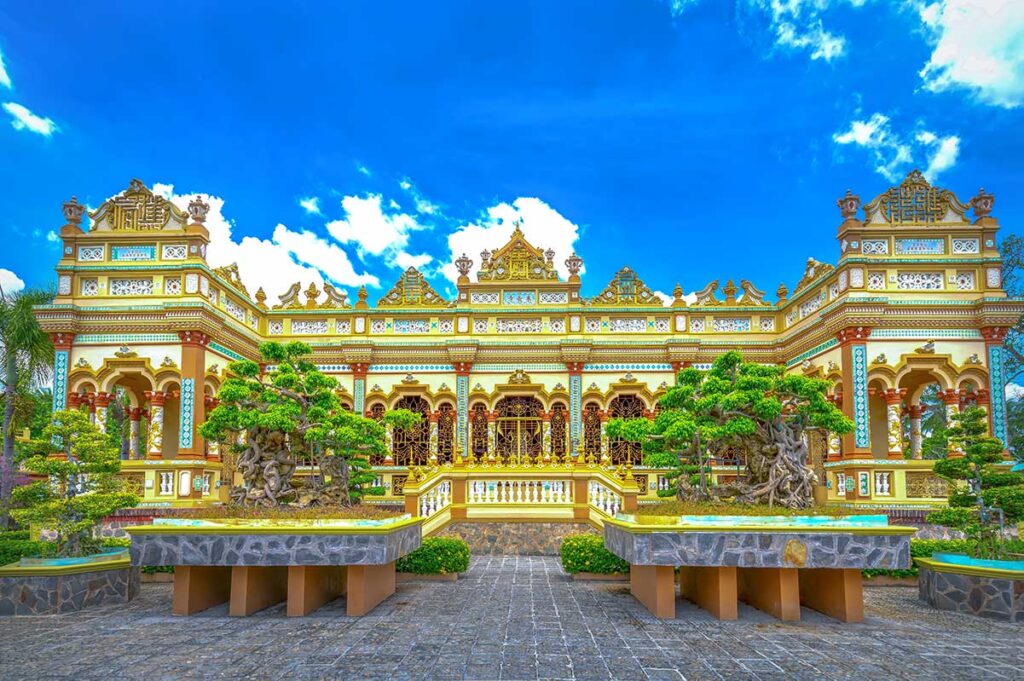What is Vinh Trang Pagoda?
Vinh Trang Pagoda is a 19th-century Buddhist temple in My Tho, Tien Giang Province, and one of the most visited religious sites in the Mekong Delta. Set in leafy gardens with bonsai, fruit trees, and shaded paths, it serves both as an active place of worship and as a cultural landmark recognized at the national level.
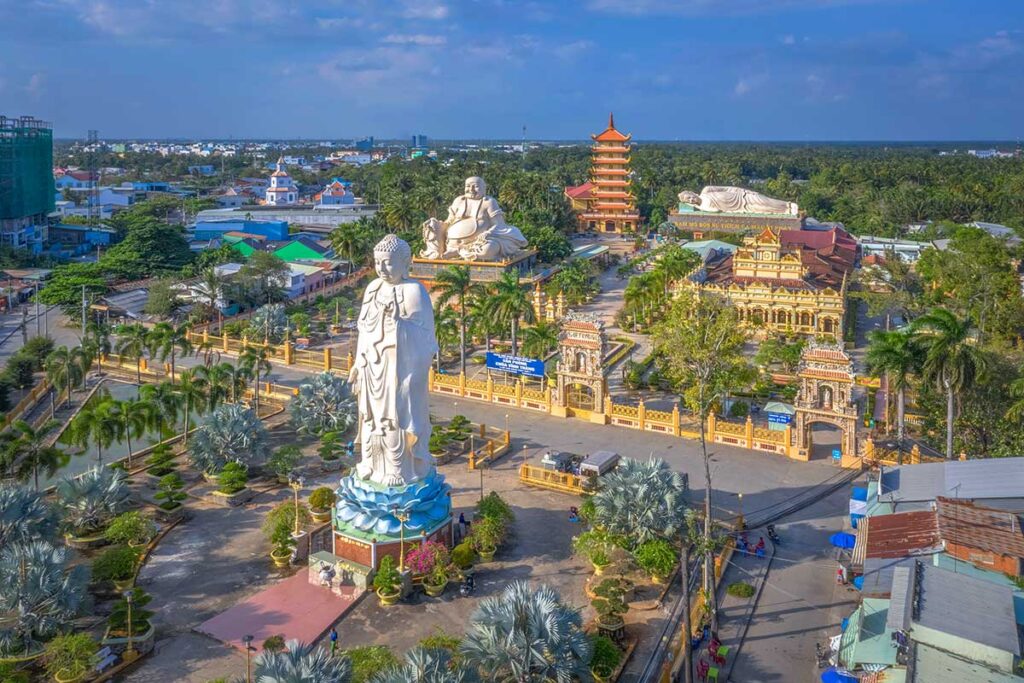
For travelers, it’s less of a half-day destination and more of a worthwhile stop—usually part of a Mekong Delta tour or combined with other local sights. The temple’s signature look is its unusual blend of Vietnamese, Chinese, and Khmer details with European-style façades and arches, giving it an appearance that feels both traditional and unexpected at the same time.
History of Vinh Trang Pagoda
Vinh Trang Pagoda was first established in the mid-19th century by Bùi Công Đạt, a district chief who invited monks to oversee its construction. Work was completed in 1850, but the temple soon suffered heavy damage during the wars between the Nguyễn dynasty and French colonial forces.
Over the following decades, several abbots rebuilt and expanded the complex. Major renovations took place in 1907 after storm damage, and again in the 1930s, when new halls were added. The most distinctive addition came in 1933, when skilled craftsmen from Huế built the ornate triple gate that still marks the entrance today.
In 1984, the pagoda was officially recognized as a national historical and cultural relic. Today, it continues to function as a place of worship and also serves as the office of the provincial Buddhist Association of Tiền Giang.
Highlights of Visiting Vinh Trang Pagoda
1. Tam Quan Triple Gate (1933)
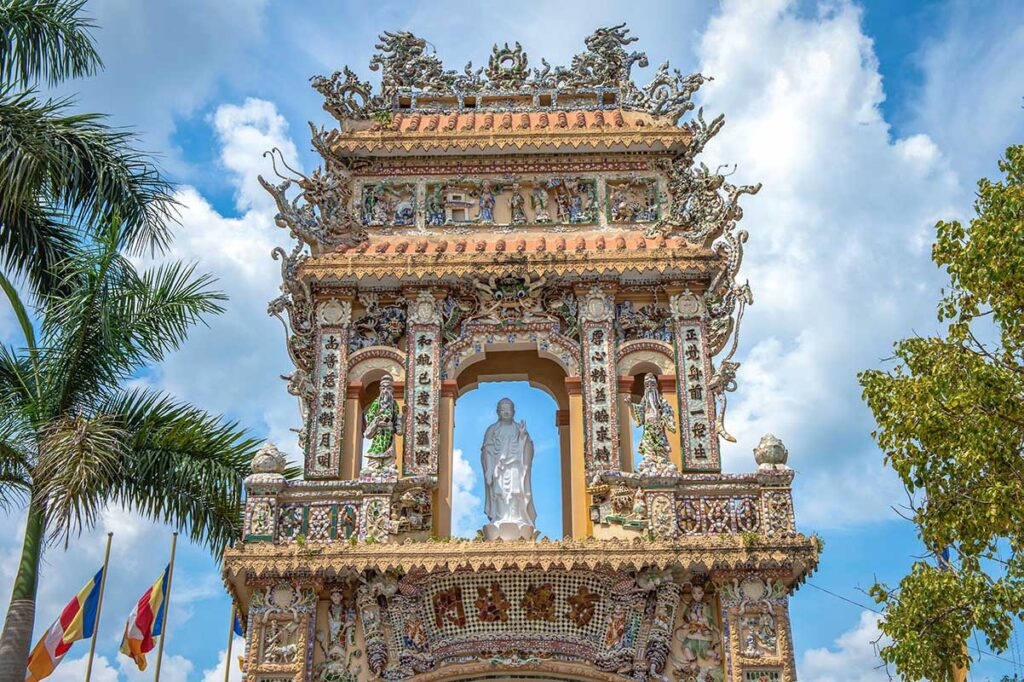
The first impression of Vinh Trang Pagoda is its ornate three-arched entrance gate, built in 1933 by craftsmen from Huế. The side gates resemble fortress towers, while the central arch is decorated with mosaics made from broken porcelain and ceramics. These reliefs illustrate Buddhist stories, mythical animals, and floral motifs. On the upper level are statues of former abbots, giving the gate not just decorative but also commemorative value.
2. Main Temple Complex
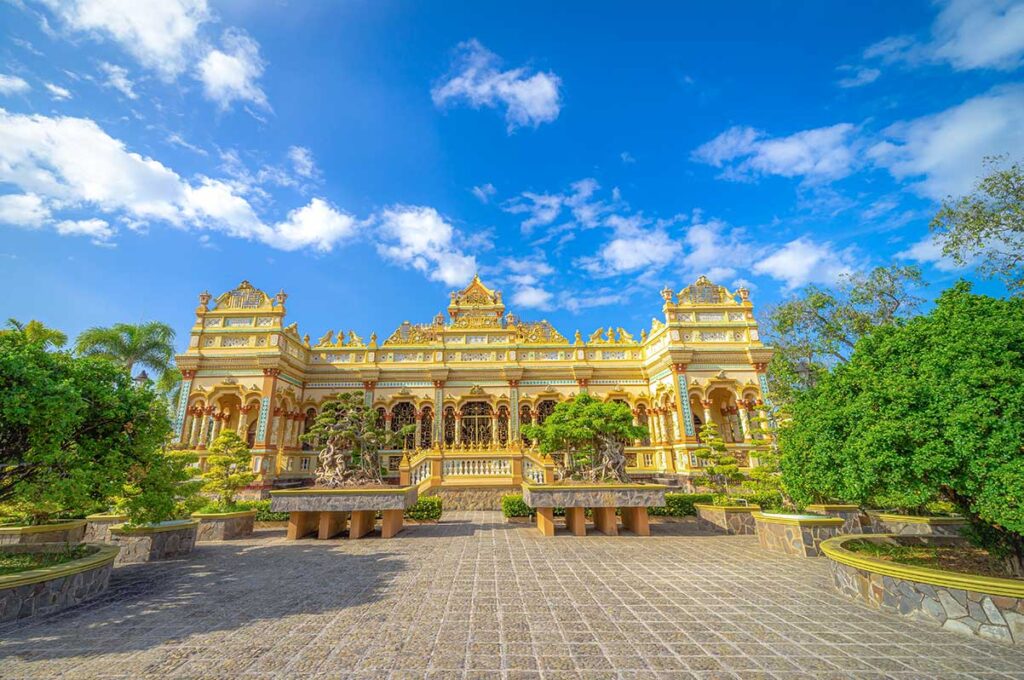
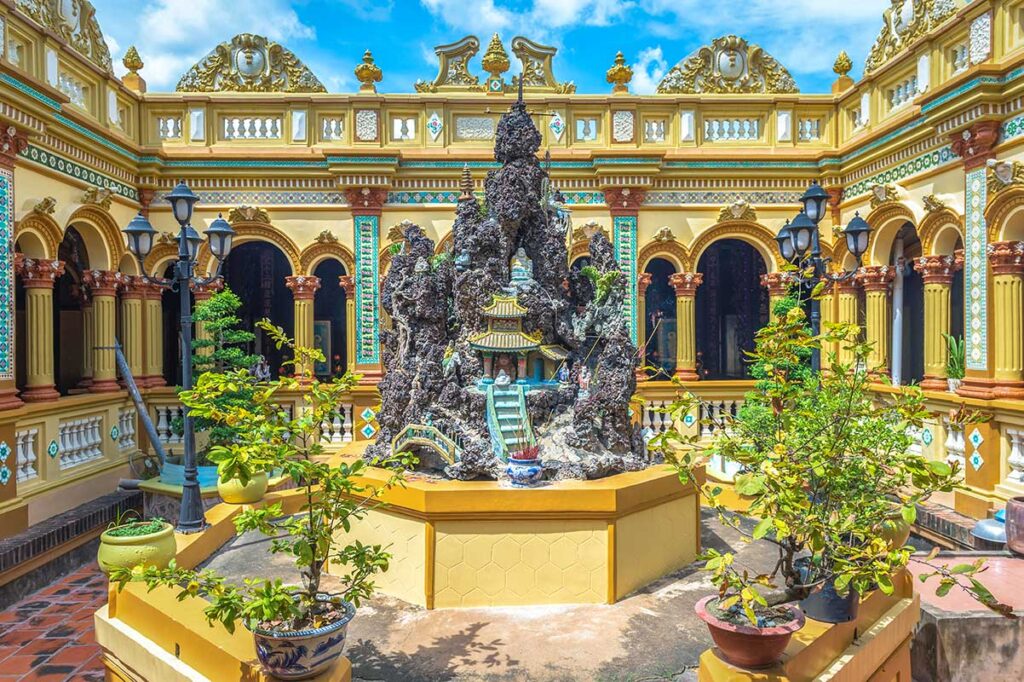
The main hall looks strikingly different from most temples in Vietnam. Its façade mixes slender European-style columns, Renaissance arches, and Roman domes with more traditional Asian elements. Decorative details include Chinese seal-style inscriptions and Japanese ceramic tiles. This blend of influences makes the building appear almost palatial from the outside.
Interior
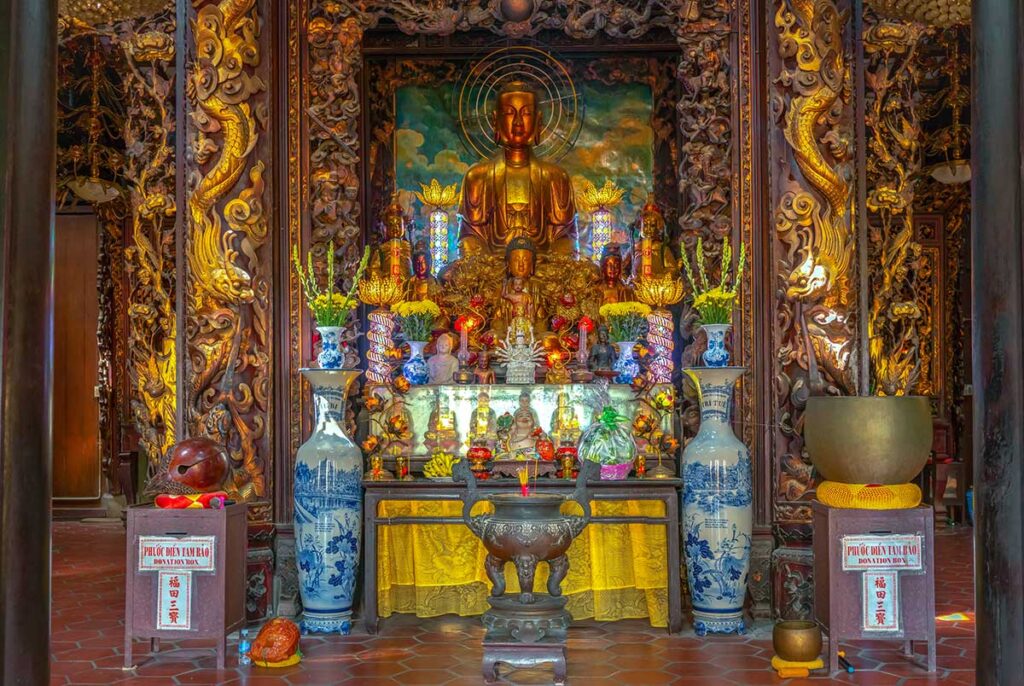
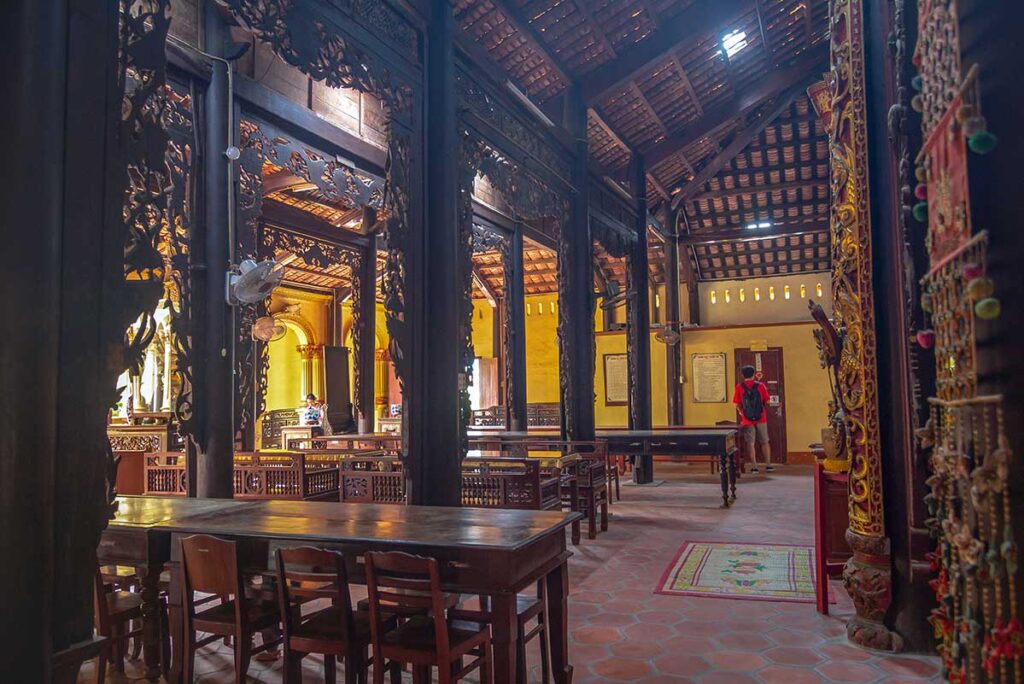
Inside, the tone shifts back to a more traditional Vietnamese pagoda. Altars are richly decorated with lacquered panels, gilded couplets, and carvings in precious woods. The hall is supported by a pair of large dragon pillars and houses an impressive collection of religious artworks created by artisans from across the country. One of the most distinctive sets is the 18 Arhats, carved from jackfruit wood around 1907. Each figure is about 80 cm tall and full of expressive detail, lining the interior walls in a sequence that feels both artistic and devotional.
3. Three Giant Buddha Statues (the “past, present, future” set)
One of the most distinctive features of Vinh Trang Pagoda is its trio of giant outdoor Buddha statues. They are not placed at random: together they represent the Buddhist concept of time and continuity—the Buddhas of the past, present, and future. This symbolic grouping is common in Mahayana Buddhist art, but at Vinh Trang it is expressed through three monumental, modern sculptures that dominate the gardens and give visitors a visual story of the Buddha’s journey across time.
Standing Amitabha Buddha (Present)
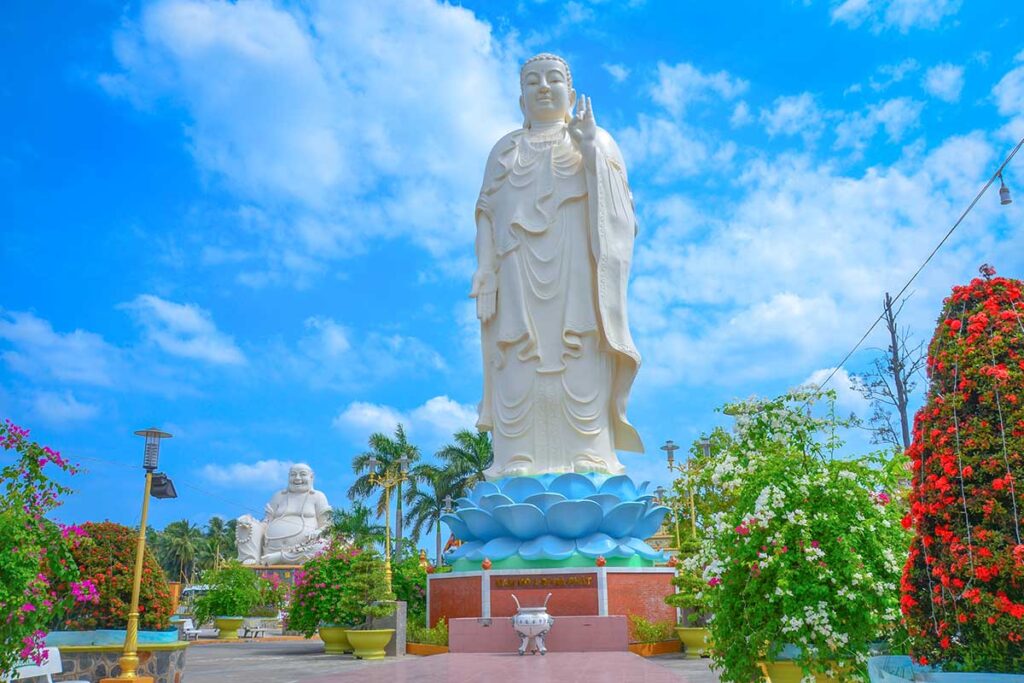
The standing Amitabha, built in 2008, rises 18 meters high and is one of the first statues visitors see from the entrance. Amitabha is the Buddha of the Western Pure Land and is often linked with the present life and the promise of rebirth. His upright pose and hand gestures symbolize reassurance and guidance, reminding worshippers of compassion in everyday existence.
Seated Maitreya Buddha (Future)
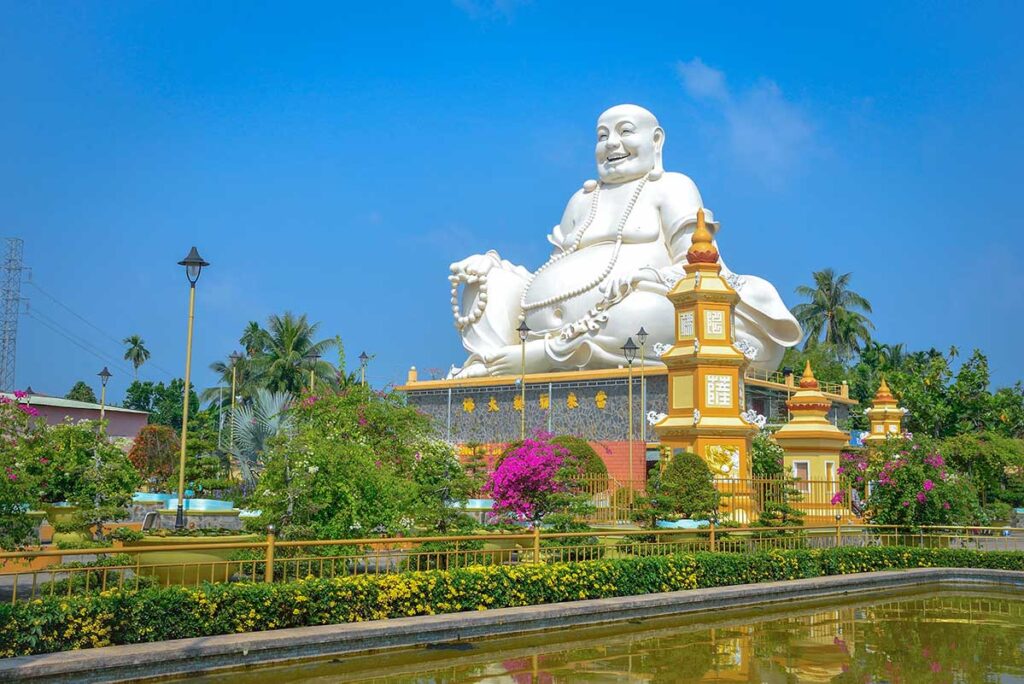
The seated Maitreya, completed in 2010, is the largest figure at around 20 meters tall and weighing over 250 tons. Maitreya is regarded as the Buddha of the future, destined to appear on earth to renew the Dharma when humanity has forgotten it. This is why he is often depicted smiling and joyful—his presence offers hope for a better, enlightened future. At Vinh Trang, the giant laughing figure sits prominently in the garden, instantly recognizable as a symbol of optimism and good fortune.
Reclining Shakyamuni Buddha (Past)
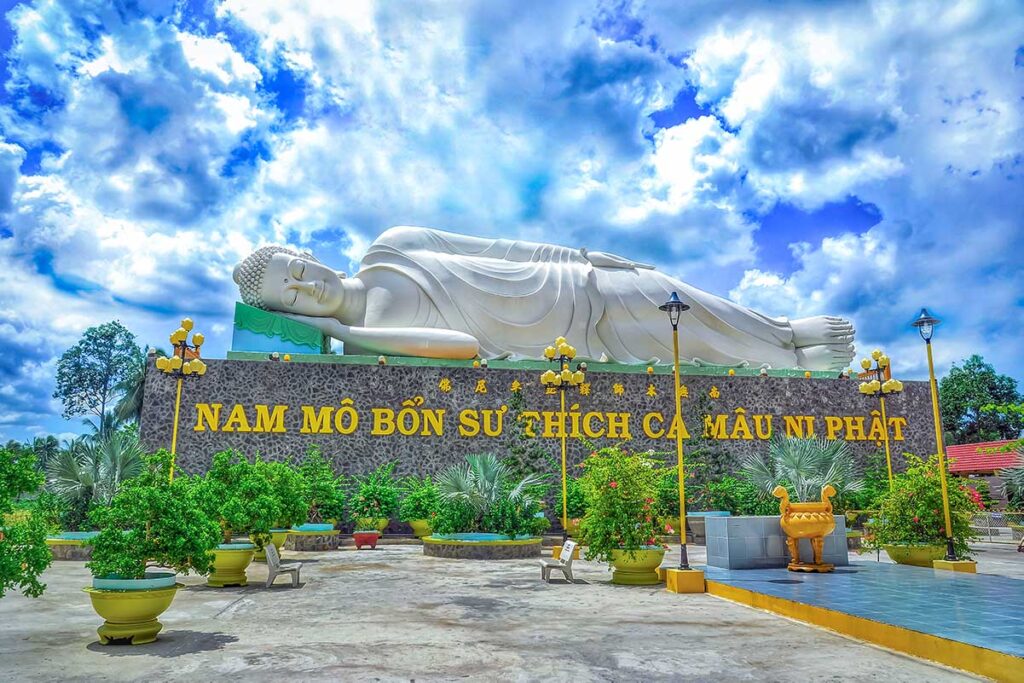
The reclining Shakyamuni, finished in 2013, stretches 32 meters in length and shows the Buddha entering parinirvana, the moment of passing away after his earthly life. This statue represents the past—the historical Buddha who lived and taught in India. The serene expression on the reclining face emphasizes detachment and peace, reminding worshippers of impermanence. Positioned toward the rear of the complex, it’s the final stop of the trio and completes the cycle of past, present, and future.
4. Seven-Story Memorial Tower (Columbarium)
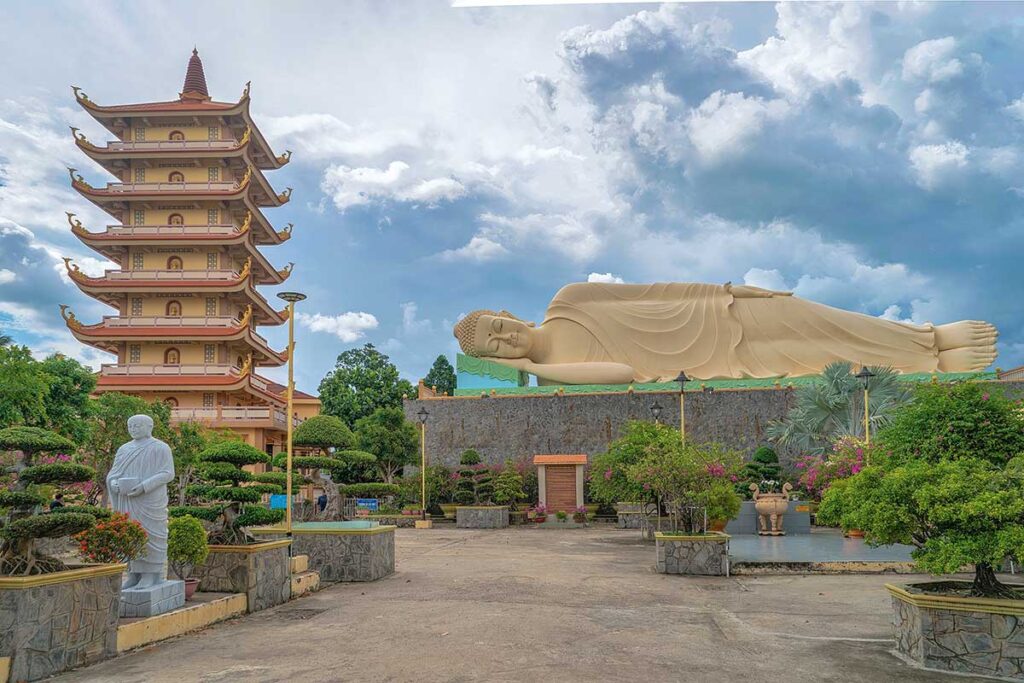
A seven-tier memorial tower stands near the reclining Buddha toward the rear of the complex. It functions as a columbarium holding the ashes of monks and lay disciples from the pagoda community. If you’re doing a full loop, pair it with the reclining Buddha before circling back to the main hall.
5. Gardens, Bonsai & Orchard Setting
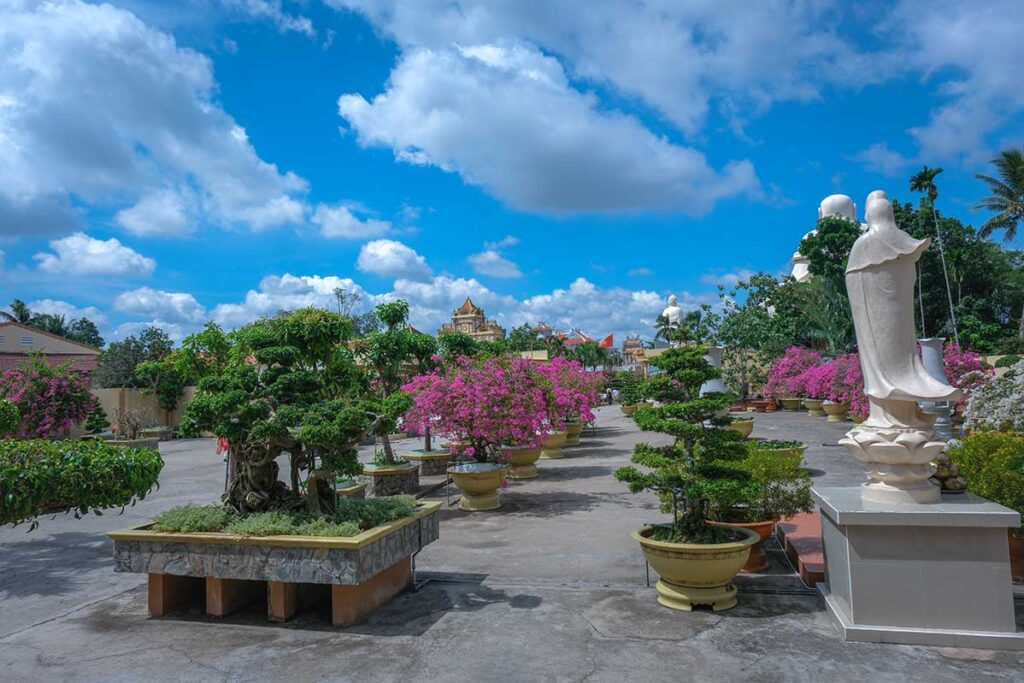
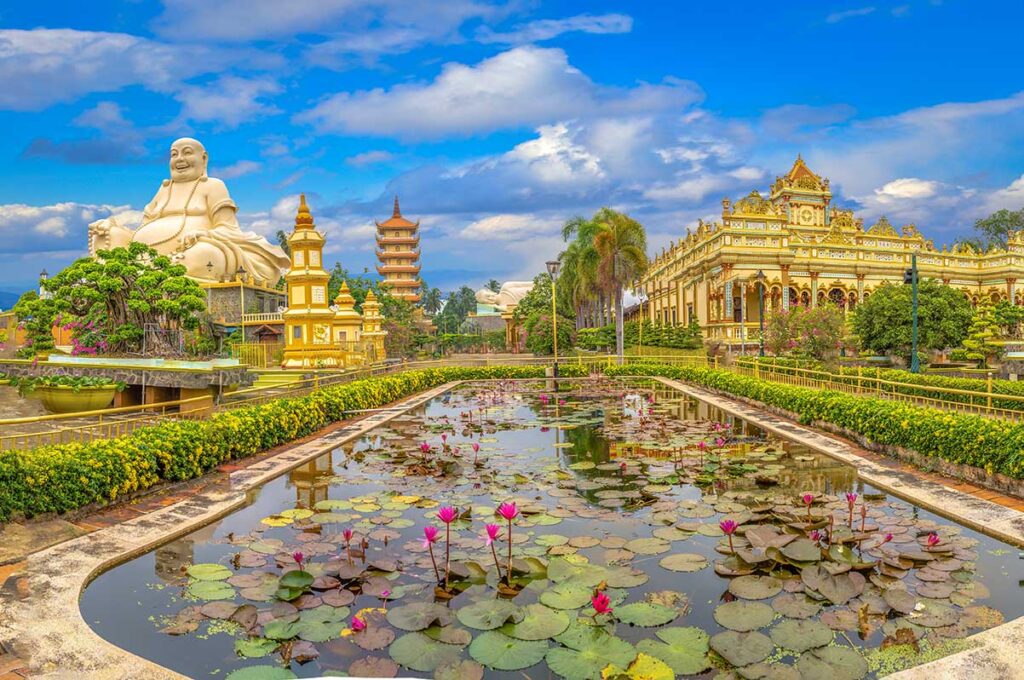
One of the charms of the pagoda is its tranquil garden. Shady walkways wind past bonsai trees, lotus ponds, and fruit orchards. While tour groups often pass quickly through, taking time to walk the paths gives a more peaceful impression of the place.
6. Smaller Structures & Notables
Scattered around the grounds are smaller features that round out the visit. These include the patriarch hall, stupas to former abbots, and a mid-19th century bronze bell engraved with the temple’s name. The oldest treasures are three bronze statues of Amitabha, Avalokiteshvara, and Mahasthamaprapta. The Avalokiteshvara statue was lost long ago and replaced with a wooden version, but the trio still represents the temple’s longest-surviving artifacts.
Location and How to Get There
Where is Vinh Trang Pagoda?
Vinh Trang Pagoda is located on Nguyen Trung Truc Street in My Tho City, Tien Giang Province, about 3–4 km from the city center. From Ho Chi Minh City, it’s roughly 70–90 km depending on the route, which translates to a drive of around 1.5–2 hours in normal traffic. This makes it one of the closest major temples in the Mekong Delta to Saigon and an easy addition to a day trip itinerary.
Part of Mekong Delta Day Trips
Most travelers visit Vinh Trang Pagoda as part of a day tour to the Mekong Delta. The temple sits conveniently on the route to My Tho’s river piers, where boats depart for the islets and canals of the Tien River. A typical tour includes a stop at the pagoda, then continues to Unicorn, Phoenix, or other small islands, where you explore fruit orchards, ride sampan boats through canals, and have a countryside lunch. For many groups, the pagoda is the quick cultural stop that balances out the nature-focused boat trip.
Travel by Yourself
If you’re not joining a tour, it’s still straightforward to reach the pagoda on your own:
- Private car with driver – The most comfortable option from Ho Chi Minh City, especially if you want to combine the temple with a boat trip in Ben Tre or My Tho. This gives flexibility to avoid crowded tour times.
- Motorbike or scooter – Practical if you’re already staying in My Tho or nearby. Most homestays and hotels rent scooters, and it allows you to combine the pagoda with markets, orchards, or rural roads in one loop. Just be sure you have a valid license and confidence riding in Vietnamese traffic.
- Taxi or ride-hailing apps – Within My Tho, the pagoda is only a short hop from the city center or the river piers, so it’s quick and inexpensive to get there this way.
Practical visiting information & Tips
Opening Hours & Entrance
Vinh Trang Pagoda is open daily from dawn to dusk, usually listed as around 6:30 AM – 7:00 PM. Entrance is free of charge, but donations are welcome, and a small contribution box is usually placed near the halls. It’s a good idea to bring some small bills in case you’d like to donate or light incense.
Dress Code & Etiquette
This is an active place of worship, so modest clothing is expected—cover shoulders and knees, and avoid anything too revealing. Shoes must be removed before entering the main hall, and hats should be taken off indoors. Keep your phone on silent and speak quietly. If you arrive during ceremonies, step to the side and observe respectfully.
Best time to visit & Duration
The pagoda is on the circuit of most Mekong Delta day tours, so it gets busiest between 10:00 AM and 3:00 PM. For a calmer visit, come early morning or late afternoon, when the light is also better for photos. The complex isn’t huge; 30–60 minutes is enough for a relaxed walk through the halls, gardens, and statues.
On-Site Services
There is parking space near the entrance, a small souvenir shop selling figurines and incense, and occasional snack stalls just outside. Facilities are basic, and signage is mostly in Vietnamese, so having a translation app (like Google Lens or similar) can help you understand the displays.
Photography Notes
You’re free to take photos outdoors, and the statues are particularly photogenic. Inside the main hall, avoid flash photography and remain unobtrusive if worshippers are present. If in doubt, follow the lead of the monks and local visitors.
Weather & Comfort
The gardens are pleasant, but there is little shade around the giant statues, which can make the walk uncomfortable in the midday sun. Bring water, sunscreen, and a hat—but remember to remove hats inside the halls. In the rainy season, an umbrella or light raincoat is useful; showers can be sudden but usually short-lived.
Other sights near Vinh Trang Pagoda to combine with
Since Vinh Trang Pagoda is usually just one stop on a broader trip to the Mekong Delta, it makes sense to combine it with other nearby attractions. The temple itself takes less than an hour to see, so most visitors pair it with a boat ride or a walk through My Tho’s town center. Here are some options to round out your day:
- Four Islands on the Tien River – Known as Dragon, Unicorn, Tortoise, and Phoenix, these small islets are the classic boat trip from My Tho. Expect coconut candy workshops, fruit orchards, and short sampan rides through leafy canals.
- My Tho Market and Riverside – A lively local market where you can browse produce, snacks, and household goods, combined with a stroll along the Mekong riverfront.
- Dieu Hoa Temple – A smaller, colorful Buddhist temple just a few minutes from the center, worth a quick stop if you enjoy visiting local religious sites.
- My Tho Cathedral – A French-built Catholic church close to the river, contrasting nicely with the Buddhist architecture of Vinh Trang.
Together, these spots make a well-rounded day trip that mixes culture, religion, and river life—without having to travel far from Ho Chi Minh City. For more ideas, see our full My Tho travel guide.
Is Vinh Trang Pagoda worth visiting?
Yes—if you’re already in My Tho or joining a Mekong Delta day tour, Vinh Trang Pagoda is worth a stop. The blend of East–West architecture and the trio of giant Buddhas make it visually striking and different from many other temples in Vietnam. The gardens are pleasant to walk through, and the scale of the statues adds a sense of grandeur that surprises many first-time visitors.
That said, the pagoda is usually included on standard tour itineraries, so it can feel busy and somewhat “tick-the-box” rather than deeply spiritual. There isn’t much signage in English, so without a guide you won’t get a lot of historical or religious context. For a quick cultural break before or after a boat trip, it fits the bill perfectly. But if you’re a traveler looking for more meditative, less touristic temple experiences, you’ll likely find them further afield in places like Soc Trang or An Giang, which require more time than a day trip.
